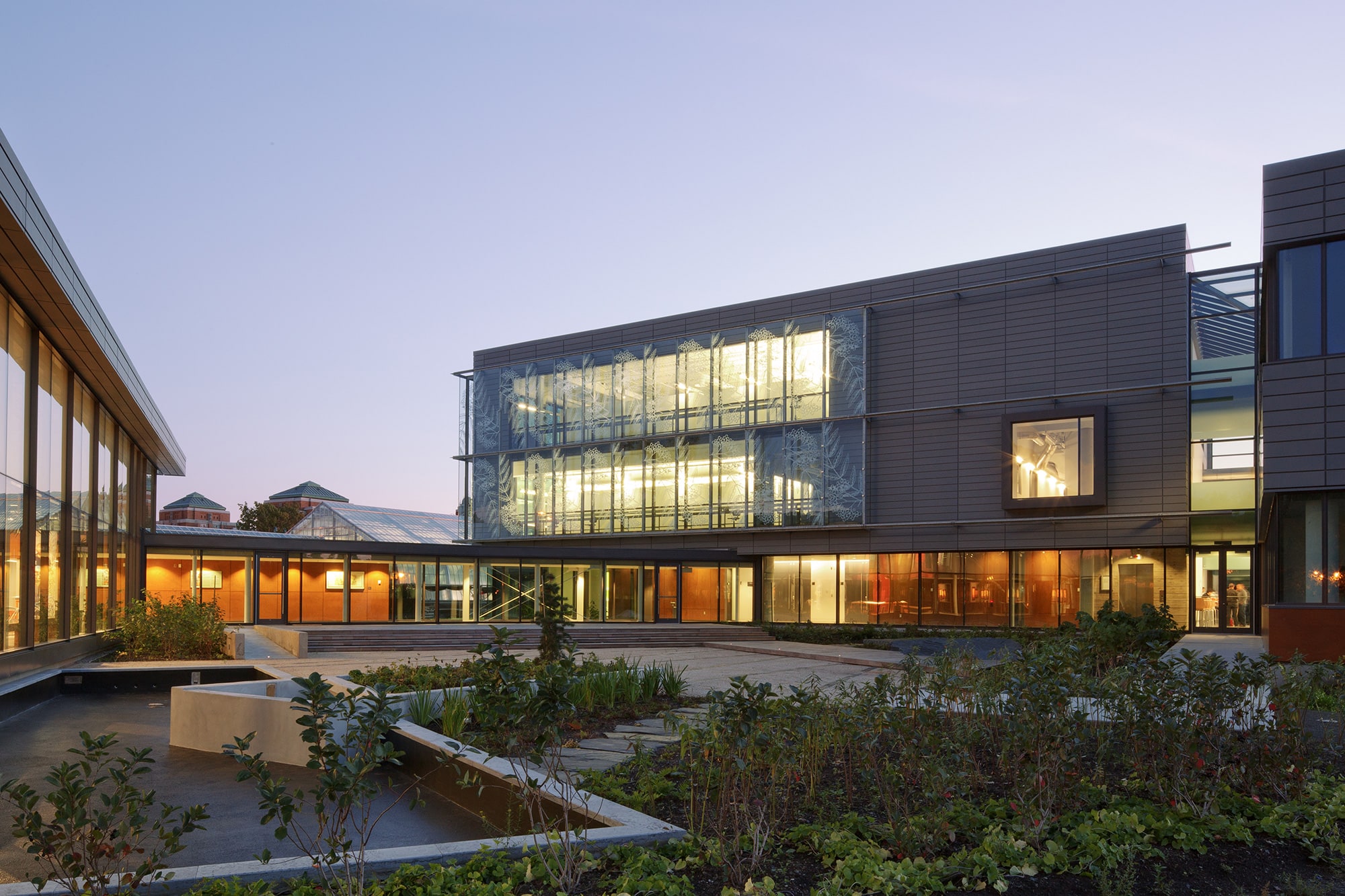Gold LEED certification for Biodiversity Centre of Université de Montréal

Last October 28th, the Biodiversity Centre of Université de Montréal received a LEED Canada NC (New Construction) Gold Level. Located on the Botanical garden’s site, the Biodiversity Centre is a joint project between the University of Montreal’s Arts and Science Faculty and the Institut de recherche en biologie végétale. The project consists of two buildings with a total area of 5,100 square meters. These are linked by a glassed-in passageway and form a central courtyard with abundant greenery, as a tribute to biodiversity. The repository of the Marie-Victorin Herbarium, the Ouellet-Robert entomological collections as well as the Insectarium and mycological collections, the Biodiversity Centre is an exceptional conservation facility and showcase of its holdings.
HIGHLIGHTS
Integration of the project into the Montreal Botanical Garden was handled masterfully, in terms of both the shape of the building and its placement, which made it possible to preserve existing elements with ecological value, such as red oaks and large cedar hedges, as well as create a courtyard affording a quality environment. The site was regenerated with a native xeriscape (ground and roof). There is very little impermeable surface, and rainwater management is incorporated: recovery, permeable surfaces and infiltration basin. Recovered rainwater is reused for the cooling pool in the courtyard and for toilets.
CHALLENGES
The project includes laboratories and conservation areas requiring controlled humidity and temperature, yielding exemplary energy efficiency. In fact, achieving a performance of over 45% above the NECB (37% based on costs) is a challenge for any type of building. This was accomplished using a combination of technologies and the mechanical efficiency of the envelope. For example, the project includes a solar wall to preheat fresh air from a portion of the building envelope made of microperforated zinc. Despite the laboratories and conservation areas, the building has several rooms with windows that open to admit abundant natural light.
ECOLOGICAL FEATURES
Sustainable Site Development
The Biodiversity Centre is located on a previously developed lot that has been decontaminated to restore outdoor spaces in their entirety. In order to encourage the use of alternative transport, no new parking spaces were added. Moreover, the building is located less than 630 meters from a subway station and within 400 m of several bus routes and a bike path. Fourteen parking spaces for bicycles were added, as well as a shower. The heat island effect is mitigated by the installation of a green roof and pale coloured impervious surfaces. Lastly, night lighting is designed to limit light pollution.
Efficient Water Management
In addition to being native, the plants selected for the project are drought tolerant and do not require watering or an irrigation system. The rainwater-fed pool in the central garden helps cool the air naturally on hot days. Moreover, much of the rainwater from the roof is recovered for toilets and urinals, which are also low flow. When these two systems are combined, potable water consumption in the building is reduced by approximately 60% annually. The unrecovered rainwater percolates through the site, reducing the burden on the municipal system and allowing natural infiltration to groundwater.
Energy and Atmosphere
Despite the constraints due to the laboratories and conservation area, the Biodiversity Centre achieves optimal energy consumption by means of ingenious applications of mechanical infrastructures that reduce energy costs by 37%. The energy savings resulting from the installation of a passive solar wall, heat recovery from exhaust air, variable speed drives on HVAC equipment, optimized equipment performance, geothermal heating and an efficient density of lighting fixtures. The HVAC equipment uses refrigerants with a reduced ozone depletion potential (no CFCs and HCFCs) and the fire safety system contains no halon.
Materials and Resources
For construction of the Biodiversity Centre, 25% of materials used were locally extracted and manufactured , including Champlain stone, stone dust, slate, concrete elements, gypsum, cabinetry wood and torrefied wood. The majority of the wood used is FSC certified. In addition, several materials such as steel, gypsum, glass, insulation, acoustical tile and resilient flooring have recycled content, for a total of more than 16%. Lastly, to extend the life of the entire building, a study of the envelope assembly in relation to the useful life of the materials was carried out.
Indoor Environment Quality
To reduce the quantities of pollutants in the building, all the adhesives, paints, primers, coatings, sealants, flooring, composite materials and the furnishings selected have emission rates (VOCs) below the prescribed limit. In addition, to reduce adverse effects on air and water quality, housekeeping is carried out with environmentally friendly products. The supply of fresh air to the building is above the recommended level, and CO2 sensors have been installed. Lastly, users have access to windows that open, and are able to control lighting, temperature and ventilation in their workplace, while 90% of the rooms have external views.
Innovation and Design Process:
The University of Montreal Biodiversity Centre, together with the LEED team and the accredited professional, set up a public education plan in order to inform users and other visitors about the various systems used to reduce the energy required for the operation of the building. All the strategies implemented combine to achieve exemplary performance in terms of reducing water consumption. In addition, all workstations were selected to meet the GreenGuard standard.
Obstacles and Solutions
The main client for this project was the University of Montreal. However, the Botanical Garden was also involved, since it is the ultimate owner of the land subject to a 30 year emphyteutic lease. The viewpoints of these two entities–the University having very specific functional requirements, the Botanical Garden wishing to maintain its image–had to be reconciled. The building is an extension of the original pavilion and greenhouses. Located at the entrance to the Park, it serves as an emblem of Space for Life. The expertise of the Botanical Garden and IRBV were also brought into play to preserve the existing vegetation and restore the native landscape.
